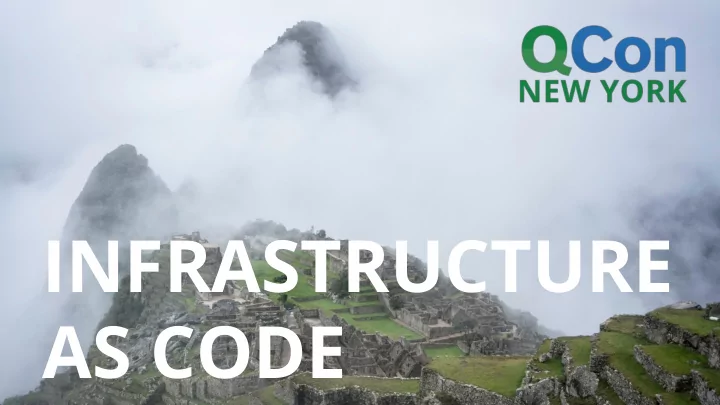

INFRASTRUCTURE AS CODE
kief@thoughtworks.com Cloud Practice Lead (UK) DevOps, Continuous Delivery, Agile Ops Twitter: @kief Book: http://oreil.ly/1JKIBVe Site: http://infrastructure-as-code.com June 2016
AGENDA CONTEXT ● Motivations ● Challenges INFRASTRUCTURE AS CODE ● Key Practices ● Simple Pipeline ● Scaling Pipelines
SPEED Get something to market quickly Iterate it Continuously improve it
TECHNOLOGY Cloud, automation, etc. lowers barriers for making changes
DANGER Security Performance Stability Compliance Maintainability
SECRET High quality services rely on the ability to make changes quickly
GOAL Be able to make changes Rapidly , Frequently , and Responsibly
CHALLENGES
SERVER SPRAWL Creating new servers is the easy part
CONFIGURATION DRIFT Servers start out identical But changes accumulate over time
AUTOMATION FEAR CYCLE
INFRASTRUCTURE AS CODE “Applying software engineering tools and practices to infrastructure”
UNATTENDED AUTOMATION Tools run on a BENEFITS OF UNATTENDED: schedule to apply, ● Discover problems quickly ● Force yourself to fix those re-apply, and update problems configuration ● Force yourself to improve your tools and processes ● Discourages “out of band” changes
AUTOMATE SERVER UPDATES Automation isn’t just for new servers! Configuration Run Chef, Puppet, Ansible, etc. on a synchronization schedule Immutable servers Apply changes by rebuilding servers Containerized Apply changes by deploying new servers container instances
RE-USE & PROMOTE DEFINITIONS Re-use the same definition files across environments for a given application or service DEV STAGE PROD Playbooks, Cookbooks, Manifests, templates, etc.
TEST INFRASTRUCTURE CHANGES Preventing Dev Oops INFRA DEV PROD TEST TEST
PIPELINES Using Continuous Delivery pipelines to manage infrastructure
WHAT? Tools are run on Changes are only agents to apply promoted after changes to passing tests & Changes are environments authorization made and committed to VCS Terraform, Puppet, etc.
WHY? Confidence for Limit direct Validates changes frequent, small changes to to infrastructure improvements to infrastructure before applying infrastructure them to production
TESTING Correctness Performance Stability Security policies
GOVERNANCE The process for applying changes is auditable Changes can be traced back to commits Automation ensures processes are followed Authorization can be required as needed
SIMPLE An example with a fairly simple environment
DEFINING A SIMPLE ENVIRONMENT VPC Subnet TERRAFORM FILE Environment structure 10.0.0.0/16 Security Group ANSIBLE PLAYBOOK 1.1.1.0/16 -> :443 Server configuration APPLICATION SOURCE Deployable application
SIMPLE PIPELINE DESIGN Deploy application, configuration, and infrastructure Application Ansible Terraform BUILD TEST PROD QA STAGE STAGE STAGE STAGE
SCALING Handling more complex infrastructure
ALIGN INFRASTRUCTURE DESIGN TO TEAMS Ensure teams can make the changes they need easily and safely
COMPLEX ENVIRONMENTS Infrastructure involving multiple teams
FAN-IN PIPELINE ServiceA SERVICE BUILD TEST ServiceB SERVICE SYSTEM BUILD QA PROD TEST TEST ServiceC SERVICE BUILD TEST
DECOUPLED PIPELINES ServiceA BUILD TEST QA PROD ServiceB BUILD TEST QA PROD ServiceC BUILD TEST QA PROD
DEPENDENCIES ServiceA BUILD TEST QA PROD Use mocks Implement and stubs Create test Consumer instance of Driven Contract provider (CDC) Tests BUILD TEST QA PROD ServiceB
ISSUE: DUPLICATION Multiple teams using similar systems, e.g. database clusters
RE-USE BY FORKING DEFINITIONS Disadvantages: Advantages: - Divergence and - Avoid tight coupling Inconsistency - Handles diverse requirements
RE-USE WITH DEFINITION LIBRARIES Challenges: Guidance: - Avoid tight coupling, so teams - Use separate pipelines for aren’t blocked when making each changes - Use CDC & other dependency - Ownership of code shared by testing strategies multiple teams
LIBRARY PIPELINE Test shared definitions before pulling them into dependent pipelines Server AMI BUILD TEST Service BUILD TEST
ISSUE: SHARED ELEMENTS ServiceA ServiceB VIP VIP Shared Service-specific LOAD BALANCER infrastructure infrastructure definitions definitions
SHARING ELEMENTS Avoid monoliths - optimize to simplify making changes
OUTCOMES ● Quickly provision and evolve infrastructure ● Effortlessly roll out fixes ● Keep systems consistent and up to date ● Spend time on high value work
kief@thoughtworks.com Cloud Practice Lead (UK) DevOps, Continuous Delivery, Agile Ops Book: http://oreil.ly/1JKIBVe Site: http://infrastructure-as-code.com Twitter: @kief
Recommend
More recommend